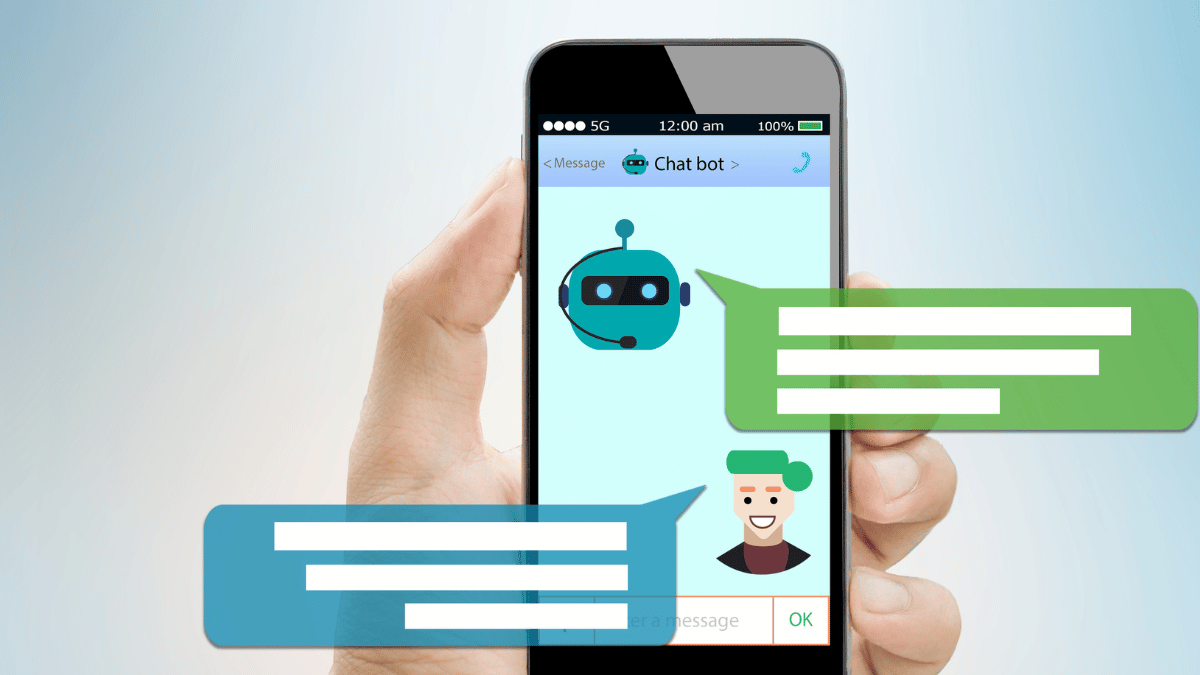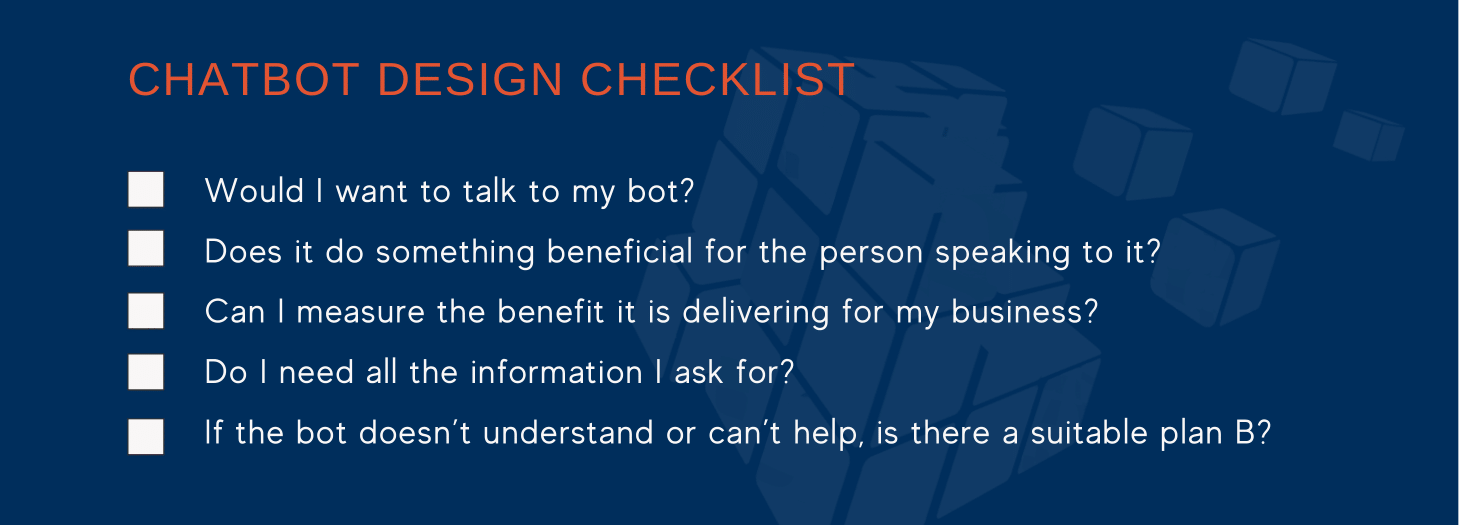
Chatbots have grown in popularity, in fact, the frenzy that was around mobile apps in 2012 has now been replaced with conversational AI technology and chatbots.
As more and more businesses jump aboard the ‘conversational train’ the need to have an understanding of how to design a chatbot and what it entails is growing. Chatbot design and how you build a bot really matters, and the success of any campaign or customer outreach hinges on it. Especially in digital debt collections. Get the tempo and tone of your chatbot conversations right and those really difficult payment conversations become less hard to have.
So, what actually goes into building a successful AI chatbot for debt collection? From the years working with clients building their collections chatbots, we have found that:
“The skill in designing difficult customer conversations is ensuring that customers have a positive conversational experience that guides customers effortlessly, and thoughtfully, on a fully personalised journey with the company that gets customers where they want, and the business needs them to be.”
So where do you start when designing your chatbot conversations? You have a blank piece of paper in front of you. What is the first step?
Stop, get a cup of your favourite hot drink, and give yourself space to think. The easiest thing to do would be to take a look back through your files at the 4-year-old SMS text you’ve been using for one-way communication and run with that. Absolutely not!
Designing your chatbot conversation is an exciting opportunity to deliver more, both for the business and customers. Done well, it will lead to higher engagement rates, less stress, and more positive customer and agent relationships.
It is worth investing time to get your initial design primed for success. Also accept, right here and now, that your chatbot, no matter how amazing it is, is going to have to change with the times. Be prepared to iterate regularly; especially in the early days when you are seeing how customers interact with your bot.
Understand the types of customers you want to engage with and how the conversation will start. Are you going out via SMS, are they coming to you over WhatsApp? There are lots of options here, whether it's SMS debt collection or WhatsApp, pick one, start there, prove the benefit, and then repeat your success across different channels and different conversations.
Write down which metrics you are trying to move. Are you looking to reduce inbound calls, increase engagement rates with customers that aren’t talking to you, or drive traffic to your website? Now ask yourself, does that metric deliver enough for both parties in the conversation i.e., customers and the business. Good conversations are productive for everyone involved and your metrics should ensure both sides of the conversation are receiving measurable success.
The initial message or greeting is vital as it will set the tone for the whole conversation. An open and supportive chatbot tone will deliver better results than a firm, instructive or directional tone.
To get a better understanding of what works, look at your non-digital conversations. Consider what a voice conversation with an agent would look like and use that as a reference when giving your bot a persona.
Examining your voice conversations should not be your finishing but your starting point. Take the principles of successful non-digital conversations and apply them to your chatbot design. Politeness, taking turns, being relevant, understanding, and empathising will give you a strong foundation but structure your digital conversation so it is concise, transparent, and effective. The aim here is for both participants, you, and the customer, to get a win.
Once you have the greeting and the outcome identified, you are ready to plan the journey. Don’t take the scenic route, the objective of your bot is to gather the information it needs to understand, pass ID verification (when required), and either provide a relevant answer or pass it across to someone that can as efficiently as possible.
Understanding the different types of conversation steps will allow you to choose the right step type at the right point in the conversation. Natural Language Understanding (NLU) will increase the conversation’s flexibility, conversational forms will allow for high levels of data to be gathered within one step without the conversation stalling due to a high level of turns, while live data values can increase the relevance of the information your bot is able to return.
Remember to build into your design the conversation management needed to report on success, get your bot to tag statuses or identify unknown inbound contacts so you understand what’s happening for your next iteration.
People won’t always respond in a way you anticipated. You may decide to use AI to generate replies but typically in a collection's conversation, you will want more control over the responses. Allow your chatbot to ask for clarification with enhanced guidance on what it can understand on each iteration. Make sure that when your bot doesn’t understand or can’t help, there is the option for a different route, and don't be overly apologetic.
The best solution here is to allow the conversation to be seamlessly moved to a human agent, while the worst solution is either to end the conversation abruptly or get stuck in a loop. Both increase frustration and will result in lost contact or higher contact via other channels.
Each 'failed' conversation is an opportunity for your chatbot to learn as the correct response can be fed back into the system for future customer interactions.
Constantly stretch the limits of the technology you have available to improve the conversation through iteration. Don’t aim for perfection on day one but deliver a demonstrable benefit that handles failure, then layer your capabilities as you get more familiar with what people want your chatbot to do.
Future iterations may see you increasing the natural language capabilities, identifying multiple entities within responses, taking payments, personalising with live data from your internal systems in real-time, and many other wonderful possibilities. However, the benefit delivered today with a simple solution is worth so much more than a beautifully designed chatbot on its 50th iteration without ever going live.
If you answer 'yes' to the questions above, then you are good to go!

So now you've designed your conversations and are ready to move onto the next project.
What if I told you that you now need to stop, and change what you’ve just done? That would probably be met with some resistance, but that is exactly what you must do – change. Nothing is ever so good that it can’t stand a little revision.
If I could give just only one piece of advice for setting yourself up for success it would be to pay attention to the ability to change, both in the initial stages of the process and more importantly, as an ongoing critical requirement.
Pay attention to how configurable your solution is. When choosing how you want to move forward with your digital conversations, consider how easy it is to build and change your solution.
You may have an internal resource to build what you want today but will that resource still be available for you in 3 months’ time when you want to change or expand? What you go live with today won’t, or at least it shouldn’t be, what you will want to be live within 12 month. You need to learn from real conversations. Your chatbot and conversation design needs to evolve with the data.
This is liberating. Go live sooner with a simpler solution and then learn and layer the capabilities as you move forward. You don’t need to wait for perfection - by the time you get there the world will have moved on.
Limit the number of individuals that have input into the later stages of the design. Everyone you ask will have an opinion and this can add weeks if not months to your project.
With a chatbot, the best decisions are made from the conversation data and to get this you need to have it live.
Ensure that whichever route you take, it is iteration enabled from the start. As a minimum, you should alter the wording of your messages without a time delay or cost hurdle. The language of your bot will change, and these are often small tweaks, but make sure you have the flexibility to do this on-demand.
When it comes to the bigger, structural changes these will need more planning. But once you have designed these changes, then updating your chatbot to handle them should be within your control. As soon as you need a developer or a third party to do the building, you are going to be restricted.
Being able to monitor your performance before and after any changes will let you truly understand what is happening, and importantly, also allow you to tell your conversation’s story to the wider organisation. This is especially important once the initial buzz quietens down.
We cannot stress enough the importance of having an iterative mindset. It is central to having successful customer conversations and can be enjoyable. Tweaking and improving chatbot and conversation design and seeing the impact on customer engagement results is very satisfying.
If you need to improve your customer engagement, talk to us and we'll show you how AI automation via digital messaging apps works.
You will love the Webio experience.
We promise.
